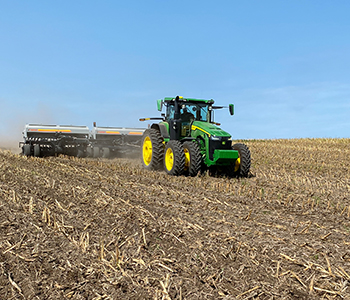Selecting the Right Cover Crop
Jun 01, 2023

Landon Van Dyke
Sales Agronomist
Every product applied to a crop goes through a process to make sure it’s the right fit. Hybrid selection, P&K rates, seed treatment, nitrogen programs and fungicide are a few examples. Cover crops are no different.
The most important aspect to establish is your goal for planting a cover crop. Is it erosion control? Feed value for livestock? Weed suppression? Nitrogen fixation? These are all common purposes for planting cover crops. Each species or mixture will have varying degrees of success depending on the goal. Select the right species, and you’ll be setting the foundation for a successful cover crop endeavor.
Secondly, keep in mind the crop which will be planted the following spring. This will dictate termination timeframe and how long the cover crop will be allowed to grow. In general, a cover crop will be more beneficial the longer it is allowed to grow. So, if you’re just starting out and wish to terminate ahead of planting, select an earlier season hybrid to begin harvest sooner. You can also time an aerial application just prior to harvest which ties right into the next aspect of selection: planting.
When will the cover crop be planted? For example, rye can be planted much later than oats since it will survive the winter. Some legume species need a certain amount growth in the fall to survive winter. All of this is done to make sure the investment spent is worth the effort.
These are the foundational approaches to selecting the right cover crop. Since there are many nuances in selection for each operation, talk with your Key Cooperative Agronomist today to start brainstorming your field’s perfect cover crop for this fall.
Sales Agronomist
Every product applied to a crop goes through a process to make sure it’s the right fit. Hybrid selection, P&K rates, seed treatment, nitrogen programs and fungicide are a few examples. Cover crops are no different.
The most important aspect to establish is your goal for planting a cover crop. Is it erosion control? Feed value for livestock? Weed suppression? Nitrogen fixation? These are all common purposes for planting cover crops. Each species or mixture will have varying degrees of success depending on the goal. Select the right species, and you’ll be setting the foundation for a successful cover crop endeavor.
Secondly, keep in mind the crop which will be planted the following spring. This will dictate termination timeframe and how long the cover crop will be allowed to grow. In general, a cover crop will be more beneficial the longer it is allowed to grow. So, if you’re just starting out and wish to terminate ahead of planting, select an earlier season hybrid to begin harvest sooner. You can also time an aerial application just prior to harvest which ties right into the next aspect of selection: planting.
When will the cover crop be planted? For example, rye can be planted much later than oats since it will survive the winter. Some legume species need a certain amount growth in the fall to survive winter. All of this is done to make sure the investment spent is worth the effort.
These are the foundational approaches to selecting the right cover crop. Since there are many nuances in selection for each operation, talk with your Key Cooperative Agronomist today to start brainstorming your field’s perfect cover crop for this fall.